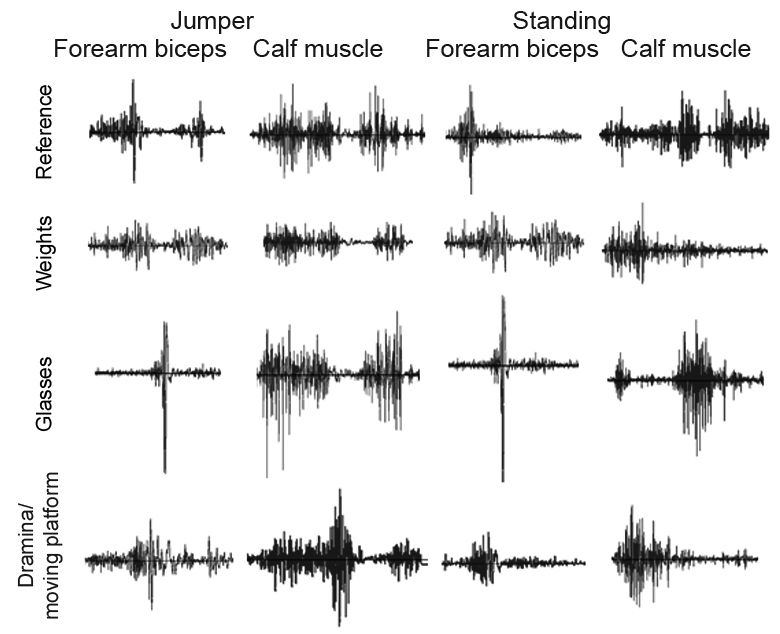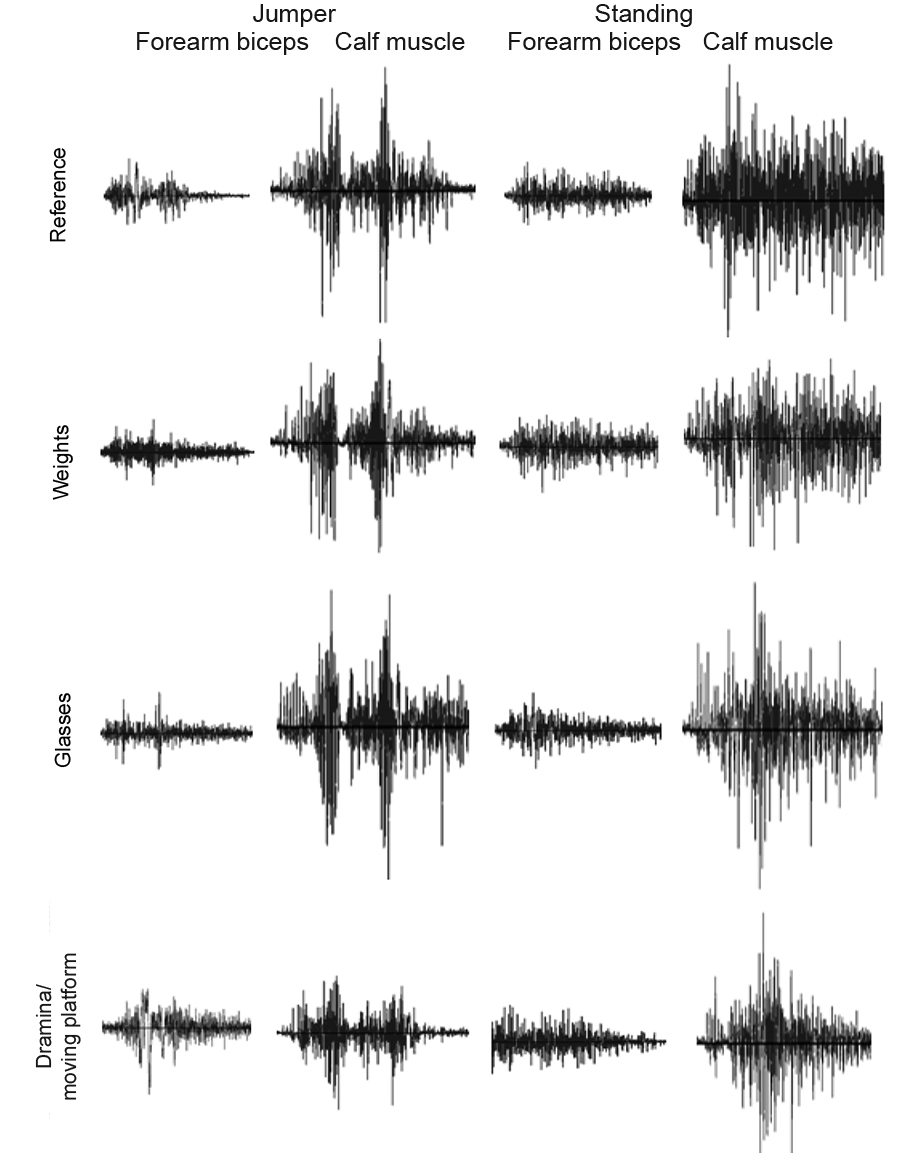Electrical activity of muscles when performing basketball shots under partial sensory deprivations
Фотографии:
ˑ:
Professor, Dr.Med. L.V. Kapilevich1
Postgraduate student O.S. Smerdova2
Postgraduate student A.V. Razuvanova2
PhD E.V. Koshel’skaya2
1National Research Tomsk State University, Tomsk
2Tomsk Research Tomsk Polytechnic University, Tomsk
Keywords: reafference, basketball, throw, electromyography.
Introduction. Current motion correction based on reafference is an important component of the rational technique of motor acts performance inclusive of sports. The concept of reafference was defined by P.K. Anokhin. Due to the acceptor of actions outcome where the goal and the ways of achieving it are programmed, the brain has a possibility to compare them with the incoming afferent information on the results and parameters of the performed action. These comparison results determine subsequent behavior structure. In the case when results of an action do not coincide with its acceptor, a mismatch occurs [1, 2].
High speed of movement limits the possibilities of motor acts correction based on reafference in sports [7, 5]. In the training process an athlete adapts to the conditions of sensory deprivation. However, the mechanisms of this adaptation and its importance in the formation of sports skills remain insufficiently studied up to date [3, 4, 6].
The research objective was to study the specifics of electrical activity of muscles in basketball shots under partial sensory deprivations.
Research method and organization. To achieve this objective 40 male athletes, mean age 21.06 ± 1.97 years, were examined. All research subjects were righthanded, did not have any disorders of vestibular, visual and motor systems. They were split into two groups based on the level of development of motor skills in the exercises «free throw standing and jumper». The study group consisted of 20 students, who practiced basketball in the university’s section, the reference one included 20 students who trained in compliance with the conditioning physical education program.
The outline of the sports-educational experiment. Each group was tested in four stages:
- Free throw under ordinary conditions: standing and jumper.
- Free throw under partial vestibular deprivation: standing, on a moving platform; jumper, 60 minutes after taking “Dramina” medication.
- Free throw under partial visual deprivation: standing, wearing prescription glasses (-5); jumper, wearing prescription glasses (-5).
- Free throw under partial musclejoint analyzer deprivation: standing, with weights on the forearms (2 kg); jumper, with weights on the forearms (2 kg).
The athletes performed 10 throws for each type at every stage (20 throws per stage). The throws were recorded as successful and unsuccessful in accordance with the official basketball rules.
The share of successful throws in each series was taken into account (as percentage). When a successful attempt was made in each series, the bioelectrical activity of the right arm biceps and right leg calf muscle was recorded. BTS FreeEMG 300 wireless electromyography unit was used to record EMG.
The data obtained were statistically processed using Statistica 6.0 Statsoft® software. The work presents the data in the following format: mean ± error of mean.
Results and discussion. Table 1 shows that the athletes of the study group performed the baseline throws much more successfully than those from the references group. At the same time jumper performance was better in both of the groups. Partial visual deprivation decreased efficiency in the reference group two times more than in the study one. At the same time partial musclejoint analyzer deprivation had a much greater effect on the athletes from the study group. Efficiency of throws standing in the reference group did not change at all.
Table 1. Basketball throw performance under partial sensory deprivations
|
CONDITIONS OF THROW PERFORMANCE |
SUCCESSFUL ATTEMPTS (% of the total of attempts made) |
||
|
Reference group |
Study group |
||
|
Baseline |
standing |
12.5±1.5 |
49±2.7 р1<0.05 |
|
jumper |
20±2.5 р2<0.05 |
59±3.7 р1<0.05 р2<0.05 |
|
|
Prescription glasses |
standing |
7.5±1.5 р3<0.05 |
39±3.1 р1<0.05 р3<0.05 |
|
jumper |
5±2.5 р3<0.05 |
28±3.89 р1<0.05 р2<0.05 р3<0.05 |
|
|
Weights on the forearm |
standing |
10±2.5 |
34±3.1 р1<0.05 р3<0.05 |
|
jumper |
13±1.8 р3<0.05 |
41±4.1 р1<0.05 р2<0.05 р3<0.05 |
|
|
«Dramina» |
jumper |
15.5±4.0 |
36±6.5 р1<0.05 |
|
Moving platform |
standing |
10±2.5 |
40±3.9 р1<0.05 р3<0.05 |
р1 – significance of differences between the study and reference groups,
р2 – significance of differences between the “jumper” and “standing” conditions,
р3 – significance of differences from the baseline conditions.
Suppressing the activity of the vestibular analyzer reduced the jumper performance only in the study group too. The same situation was observed when performing throws while standing on a moving platform.
While analyzing muscle bioelectrical activity it was found that in the reference group disorganization of muscle contraction is the most notable under partial visual deprivation (Figure 1). Using the weights distorted the activity of the forearm biceps only, and the throw while standing on a moving platform – on the contrary, that of the calf muscle only.

Figure 1. Muscle bioelectrical activity during reference group players' shot performance
In case of the athletes of the study group the nature of the calf muscles activity hardly changed under any kinds of deprivation (Figure 2). Their activity reduced only in the case of the moving platform. Disorganization of the forearm biceps activity was observed against the background of taking “Dramina” (jumper) and on a moving platform (throw standing).

Figure 2. Muscle bioelectrical activity during study group players' shot performance
Conclusion. The obtained results indicate that in the absence of motor skill visual analyzer is crucial for ensuring corrective actions, visual deprivation violates coordination of all muscle groups and reduces the efficiency of throws. The role of the visual analyzer is reduced in athletes, the reafference from vestibular and musclejoint analyzers comes to the fore. The disorganization of muscular activity is expressed to a much lesser degree and is local.
References
- Anokhin, P.K. Uzlovye voprosy teorii funktsional’noy sistemy (Central questions of theory of functional system) / P.K. Anokhin. – Moscow: Nauka, 1980. – 197 P.
- Kazennikov, O.V. Ob uchastii pervichnoy motornoy kory v programmirovanii dvigatel’noy aktivnosti pri lovle gruza (Primary motor cortex involvement in programmed motor activity when catching weight) / O.V. Kazennikov, M.I. Lipshits // Fiziologiya cheloveka (Human Physiology). – 2011. – V. 37. – № 5. – P. 108112.
- Kapilevich, L.V. Fiziologicheskiy kontrol’ tekhnicheskoy podgotovki sportsmenov (Physiological control of technical training of athletes) / L.V. Kapilevich // Teoriya i praktika fizicheskoy kultury. – 2010. – № 11. – P. 1215.
- Kapilevich, L.V. Fiziologicheskie mekhanizmy koordinatsii dvizheniy v bezopornom polozhenii u sportsmenov (Physiological mechanisms of coordination in the unsupported position in athletes) / L.V. Kapilevich // Teoriya i praktika fizicheskoy kultury. – 2012. – № 7. – P. 4548.
- Koshel’skaya, E.V. Upravlenie sportsmenami polozheniem tela v prostranstve v faze poleta (Athletes’ control of their body position in space in flight phase) / E.V. Koshel’skaya, A.V. Razuvanova, O.S. Smerdova et al. // Teoriya i praktika fizicheskoy kultury. – 2014. – № 12. – P. 4749.
- Koshel’skaya, E.V. Fiziologicheskie i biomekhanicheskie kharakteristiki tekhniki udarnotselevykh deystviy futbolistov (Physiological and biomechanical characteristics of targeted kicking technique in football) / E.V. Koshel’skaya, Kapilevich, V.N. Bazhenov, V.I. Andreev, O.I. Buravel' // Byulleten’ eksperimental’noy biologii i meditsiny (Bulletin of experimental biology and medicine). – 2012. v. 153. – № 2. – P. 235237.
- Pritykin, V.N. Opredelenie optimal’nykh traektoriy poleta myacha i kharakteristik tseli v basketbole pri broskakh po kol’tsu so srednikh i dal’nikh distantsiy (Allocation of optimal ball trajectories and target characteristics in basketball when hoop shooting from middle and long distances) / V.N. Pritykin, V.A. Lesukov, A.A. Geraskin, A.V. Rodionov // Teoriya i praktika fizicheskoy kul’tury. – 1996. – № 10.
Corresponding author: kapil@yandex.ru




